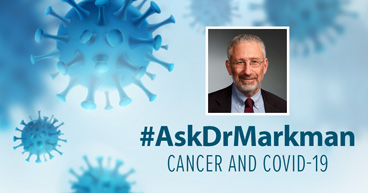
Millions of people have managed to keep their medical appointments during the COVID-19 pandemic without leaving their homes. As lockdowns and social distancing took hold a year ago, telehealth technology offered a convenient new option, allowing patients to shift many of their scheduled meetings with doctors from in-office appointments to video visits over their smart phones, tablets or computers.
The U.S. Centers for Disease Control and Prevention (CDC) is easing up its recommended masking and social distancing restrictions now that some 150 million Americans have received at least one dose of a COVID-19 vaccine and a growing number are becoming fully immunized every day.
Medical providers are now determining how significant a role telehealth services will play moving forward. When it comes to cancer care, an expanded role for telehealth video visits is part of a developing hybrid model of patient care, says Chevon Rariy, MD, Director of Telehealth at Cancer Treatment Centers of America® (CTCA) and Medical Director of Endocrinology at CTCA® Chicago.
Before the pandemic, telehealth services were not used significantly in cancer care, Dr. Rariy says, and most often they were limited to urgent-care issues patients were experiencing. The proliferation of telehealth appointments during the pandemic changed that approach, she says, with telehealth now seen as “feasible, encouraged—and, quite frankly—helping to provide better outcomes.”
“During the pandemic virtual care helped to bridge the gap, allowing us to continue to treat our patients,” Dr. Rariy says. “While virtual consultations will not replace the importance of in-person care, especially as it relates to times when a physical exam is required—or additional labs, imaging, or procedures are needed—it continues to play a critical role in health care moving forward.”
Telehealth augments face-to-face office visits, Dr. Rariy says. For instance, the online encounters provide a means to quickly assess symptoms or help with symptom management, to help manage pain or chronic disease, she says.
Is it covered?
Health insurers adapted their policies in response to the pandemic, greatly expanding telehealth coverage and reimbursement eligibility. The role telehealth services play in the future may depend heavily on the level of coverage private and public insurers are willing to provide once the COVID-19 public health emergency officially ends.
The U.S. Centers for Medicare & Medicaid Services (CMS) has extended Medicare payments for many telehealth services until at least the end of 2021. However, when officials declare the COVID-19 public health emergency over, CMS says it won’t have the authority to allow payment for those services outside of rural areas. In Congress, the proposed Telehealth Modernization Act seeks to make telehealth coverage a permanent part of Medicare coverage.
The CMS reports that prior to the pandemic, Medicare was paying for roughly 15,000 telemedicine visits each week, or about 780,000 telehealth visits a year. In the first six months of the pandemic alone, after Medicare temporarily added 144 covered telehealth services to its plan, more than 24.5 million Medicare beneficiaries had at least one telehealth appointment.
Positive reaction to telehealth
A six-week study of telehealth video visits during the pandemic at Houston Methodist Cancer Center showed that, of the 1,762 patients offered a telehealth visit, 83.8 percent took part in one. Of those participants, 92.6 percent were satisfied with their telehealth video visits, as were 65.2 percent of the doctors involved. “Primary concerns that physicians had in using this technology were inadequate patient interactions and acquisition of medical data, increased potential for missing significant clinical findings, decreased quality of care, and potential medical liability,” the study says.
But Dr. Rariy thinks the telehealth connection provides its own advantages for physicians and other health providers, especially when used in combination with in-office appointments, and it doesn’t replace the personal touch.
“You’re able to see into the patient’s home when you’re having your visit. This would never be possible without telehealth,” Dr. Rariy says. “If patients are coming into your hospital in a sterile environment, you have no idea what their home looks like or perhaps what challenges they may face—what help they need in order to execute your care plan. But when you’re speaking to them through telehealth video over the phone, you’re able to gain that awareness.”
Expanding telehealth fields
The growth in telehealth won’t be limited to video visits. It may also be used to provide regular health information to your cancer care providers between appointments.
“We’re going to be deploying remote patient monitoring,” Rariy says. Patients will self-report the information on a regular basis on mobile devices—including vital signs such as blood pressure, heart rate and weight, activity level and symptoms they’re experiencing—allowing for early intervention by their cancer care team when appropriate.
“So, it’s not a device that’s going to automatically know you’re nauseous. Patients have to report that they’re nauseous. It’s a survey, a symptom tracker,” Rariy says. “Patients would be able to escalate their concerns to their care team when needed, at the time it’s needed. It may prevent emergency room visits and hospital admissions, because the symptoms are caught early.”
When to use telehealth, when to schedule an office visit
There are many times when a telehealth video visit will work fine and may fit into your schedule better than an office visit. These include:
- Appointments to review a CT scan or other laboratory or imaging test results
- Discussions concerning treatment options, pain management or symptom and side-effect management
- Discussions that include other family members
- Surveillance visits or pre- or post-surgical follow-ups
- Second opinion consultations
Not every visit can be done via telehealth. “It is now equally important to ensure that patients do not delay treatments and services that require in-person care,” Dr. Rariy says. “Patients who require life-saving infusion therapy, surgery, radiation therapy, special diagnostic scans, or a procedure to determine the cancer progression or remission should speak with their care team to schedule in-person appointments.”
People should also schedule recommended cancer screenings, which many may have postponed during the pandemic, she says. Health professionals fear many treatable cancers have gone undetected during the pandemic because of delayed screenings.
The ABCs of a telehealth visit
If you’re scheduled for your first telehealth video visit, there’s no need to panic or worry. It may appear daunting if you aren’t technologically savvy, but the steps are simple, and many health care providers have someone on staff to walk you through the process. The video visits may be conducted from a laptop computer, tablet or smart phone. Many times, all you have to do is click on a link sent to you in an email from your health care provider. Sometimes, you may have to download an app first.
At CTCA, these steps are typical once a telehealth appointment is scheduled:
- The patient receives a confirmation email and a call from a telehealth support team member, with follow-up email reminders a day before the appointment and the day of the appointment.
- At the time of the scheduled appointment, the patient can open the last email and click on the link.
- Patients on a computer are prompted to join the meeting via a web browser (ask your provider if he or she has a preferred browser), while those on a smart phone are asked to download the Microsoft Teams app and join from there.
- Once connected, the patient is put into a virtual lobby until the doctor or other health professional appears.
Telehealth tips for patients
The following reminders may help your telehealth visit go more smoothly:
- Make sure your phone or computer is adequately charged before your visit, or that it’s plugged in and charging during the visit.
- Pick a room that’s private and well-lit, with little background noise, and where you won’t be interrupted; earbuds or headphones may help with hearing and privacy.
- Use a device that has a camera so your health care provider can see you while you’re looking at the screen.
- Expect the unexpected. The technology doesn’t always work perfectly. If you’re disconnected for some reason, just call back or click the link again to resume your appointment. Your health care provider is probably also working to reestablish the connection.
- If appropriate, have some basic health information ready for your health care provider. Weigh yourself before the appointment if you have a scale. If you have a blood pressure cuff, take that reading as well. You may have other medical devices that provide measurements important for your visit.
- Be prepared. Write down questions ahead of time so you don’t forget what you want to ask. Also, list symptoms or anything you’re experiencing that appears abnormal.
- Don’t multi-task. Focus your attention on your appointment, just like you would do if you were in the doctor’s office. Don’t try to take the appointment while driving.
- If a caregiver or family member plans to join the session, make sure he or she is nearby when the appointment time nears.



